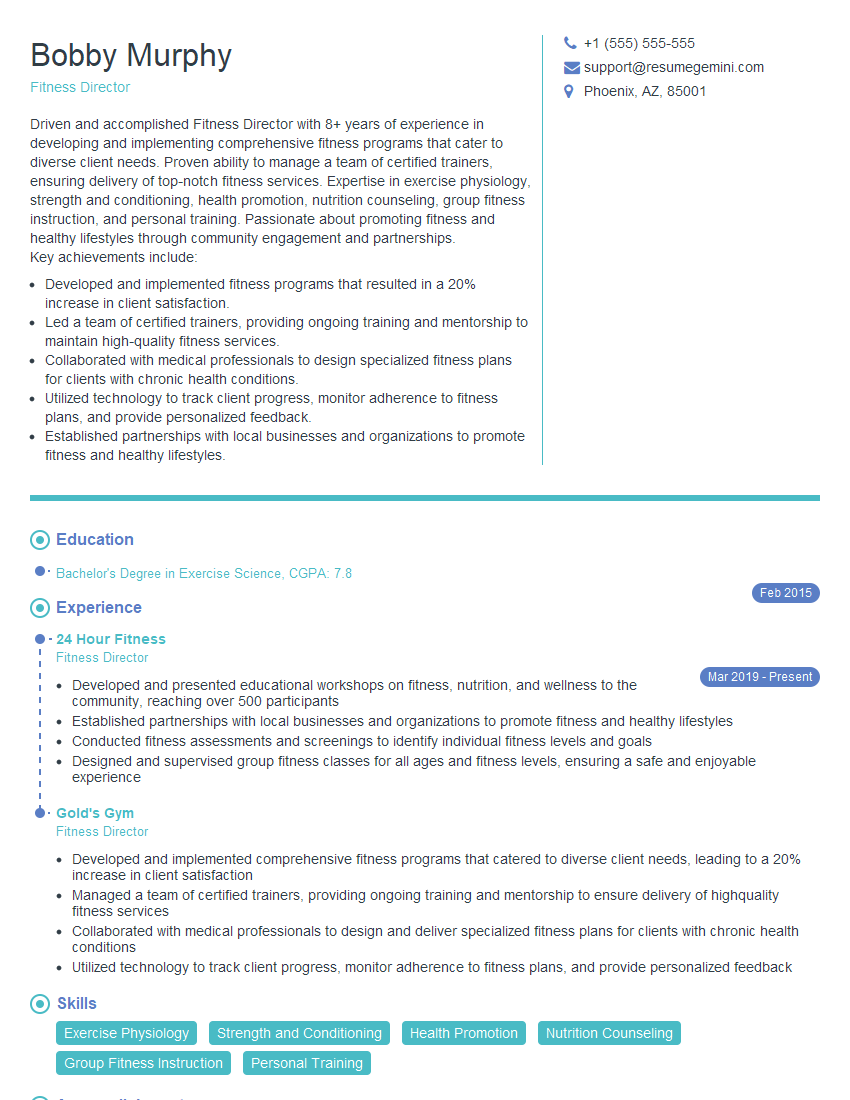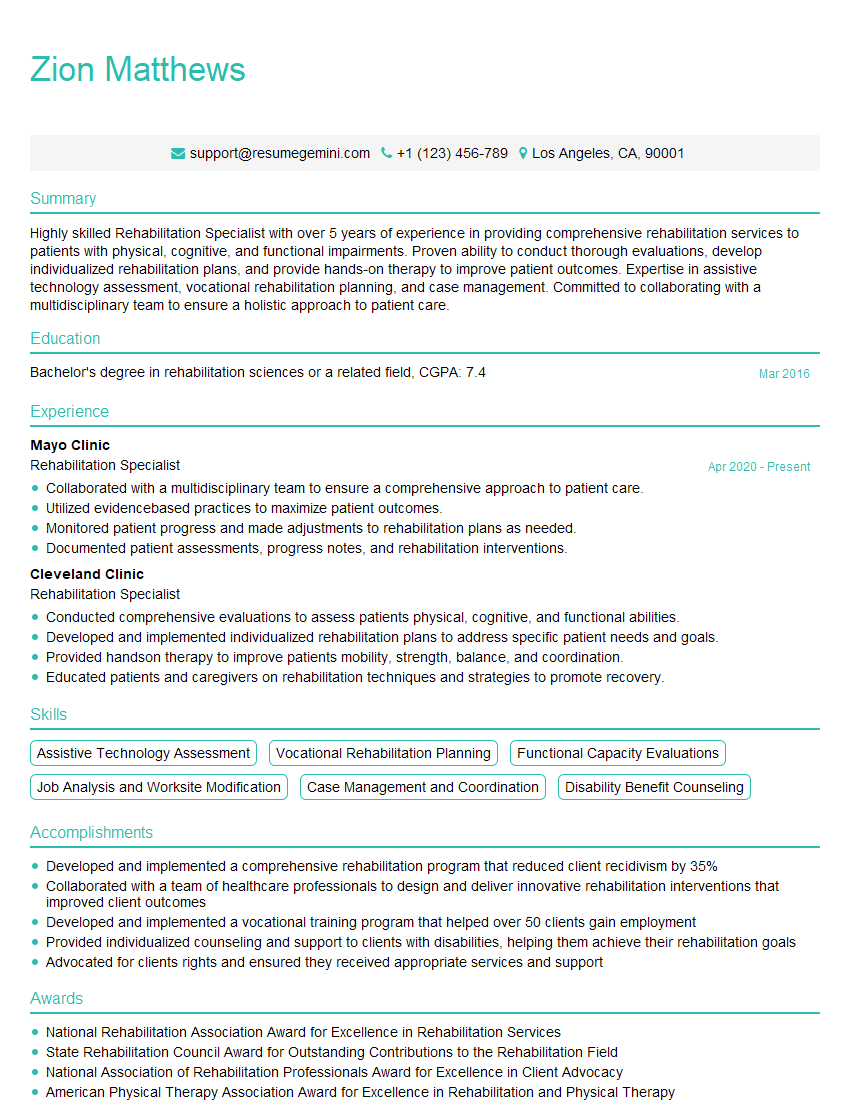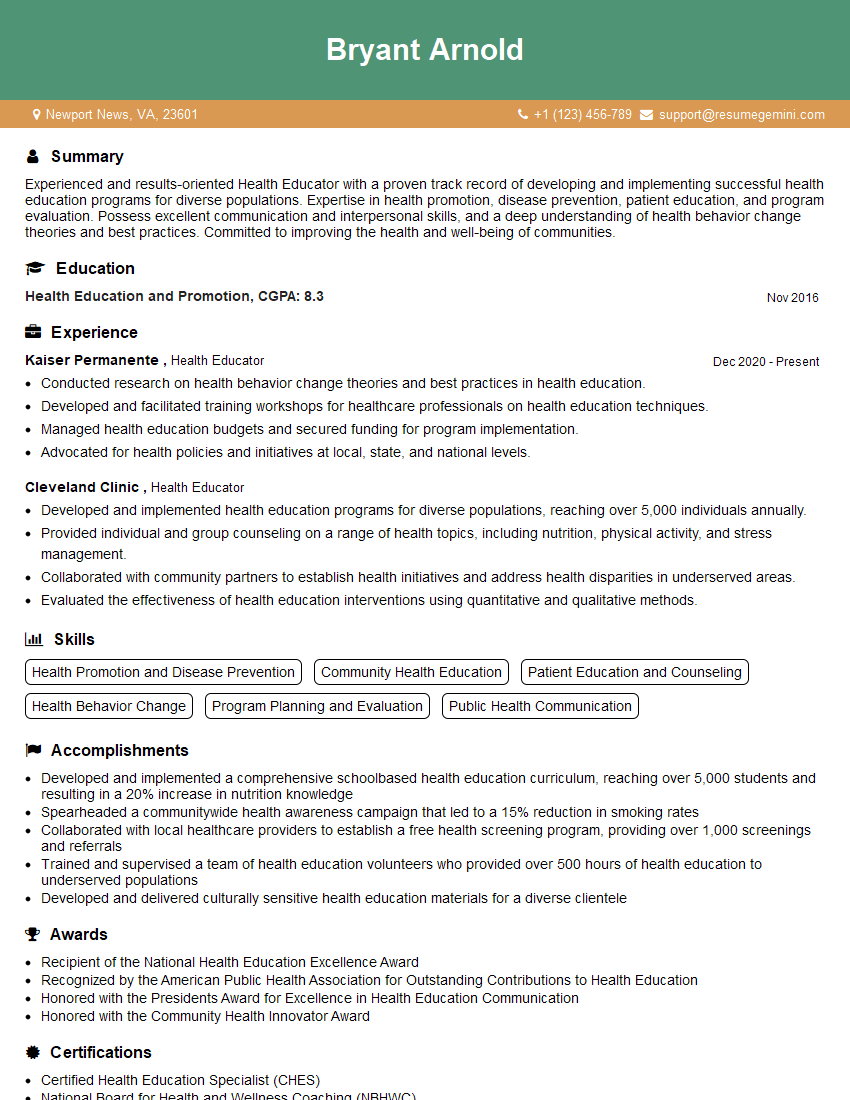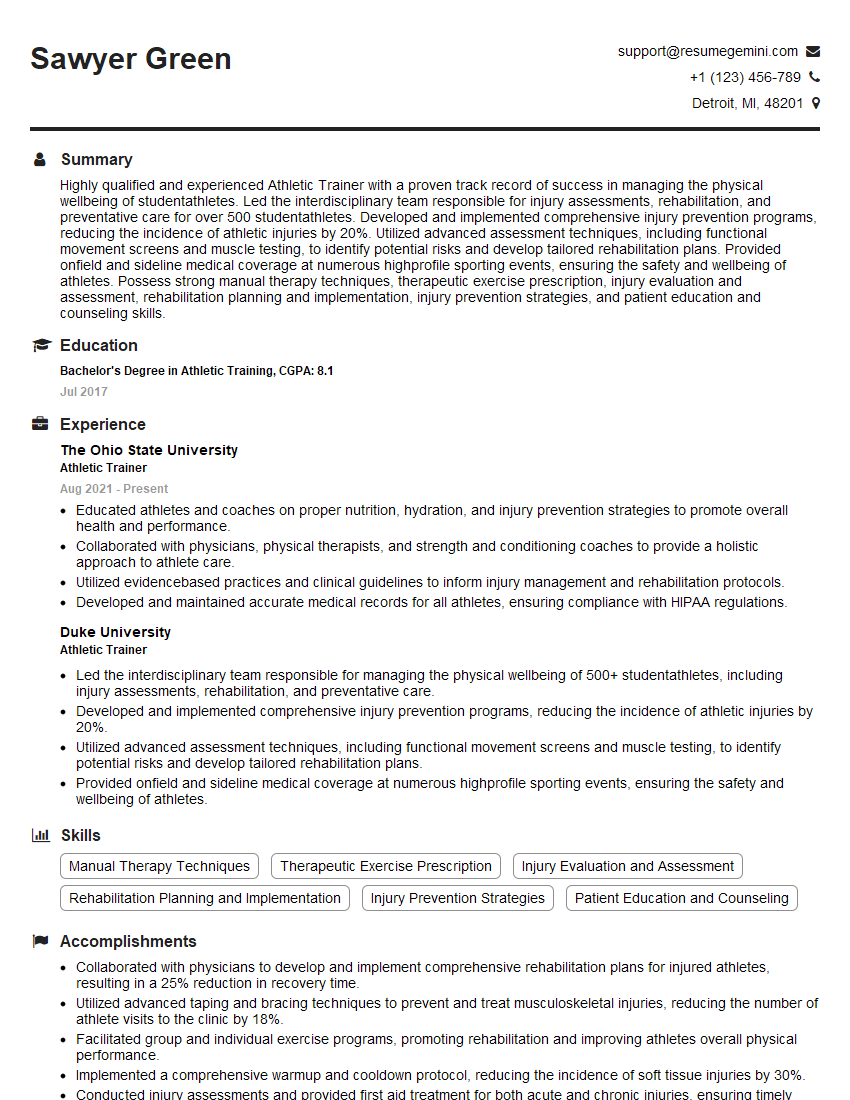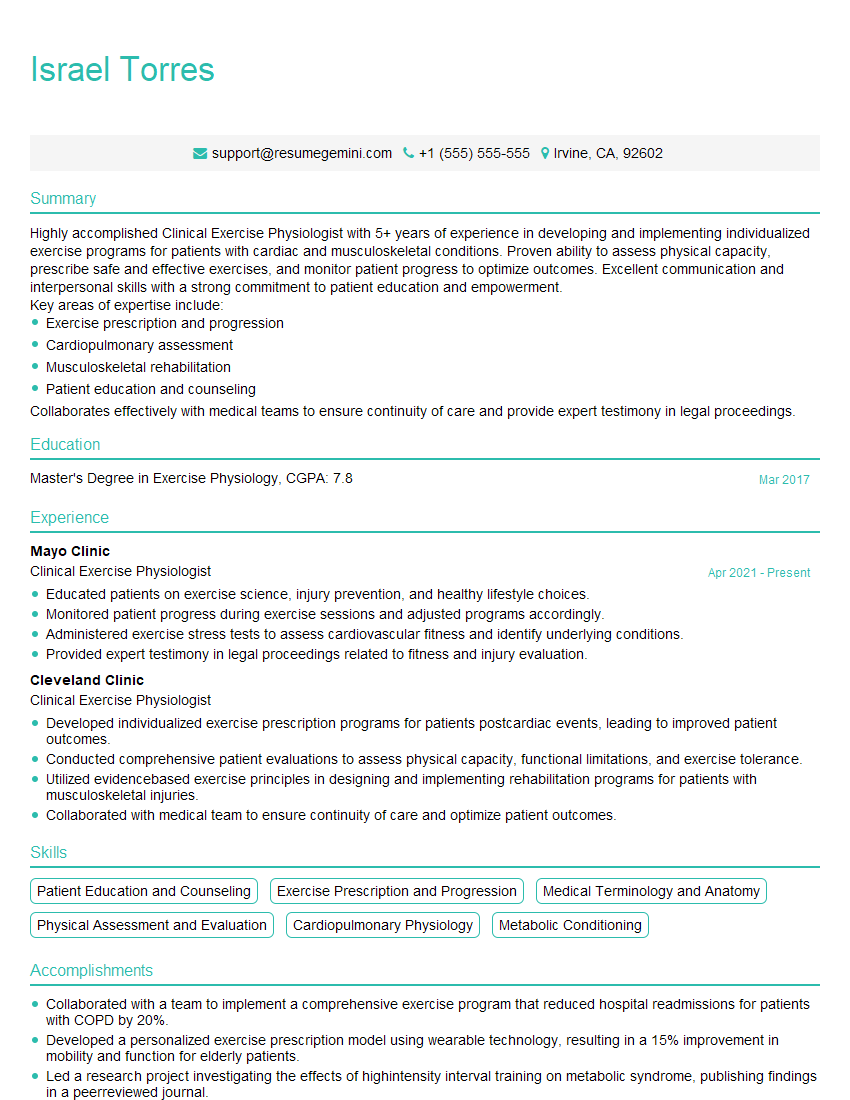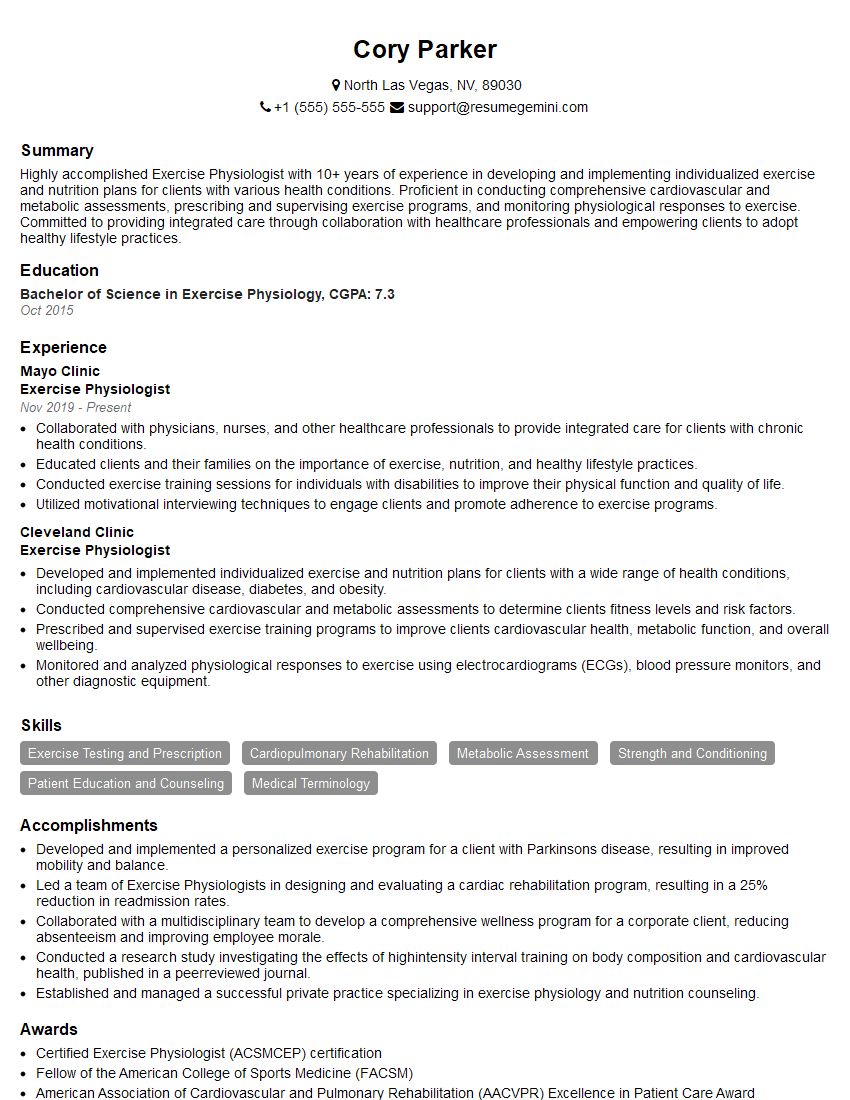The right preparation can turn an interview into an opportunity to showcase your expertise. This guide to Cardiorespiratory Training interview questions is your ultimate resource, providing key insights and tips to help you ace your responses and stand out as a top candidate.
Questions Asked in Cardiorespiratory Training Interview
Q 1. Explain the principles of cardiorespiratory training.
Cardiorespiratory training, also known as cardio, aims to improve the efficiency of your heart and lungs. It operates on several key principles:
- Overload: To improve, you must consistently challenge your system beyond its current capacity. This means increasing the intensity, duration, or frequency of your workouts over time.
- Progression: Gradually increasing the overload to avoid plateaus and injuries. It’s like climbing a mountain – you wouldn’t sprint to the top; you’d gradually ascend.
- Specificity: Training should be tailored to your specific goals. If you aim to run a marathon, your training will differ from someone aiming to improve their swimming.
- Individuality: Everyone responds differently to training. What works for one person may not work for another. Factors like genetics, age, and current fitness level play a role.
- Reversibility: The benefits of training are lost if you stop. This highlights the importance of consistency.
- Rest and Recovery: Adequate rest allows your body to repair and adapt to the stress of training. Ignoring this principle can lead to overtraining and injury.
Understanding and applying these principles ensures effective and safe cardiorespiratory training.
Q 2. Describe the components of fitness relevant to cardiorespiratory health.
Several components of fitness are crucial for optimal cardiorespiratory health:
- Cardiorespiratory Endurance: The ability of your heart, lungs, and blood vessels to deliver oxygen to your muscles during sustained physical activity. This is the primary focus of cardiorespiratory training.
- Muscular Strength: While not directly cardiorespiratory, strength training supports overall fitness and can enhance performance in cardio activities.
- Muscular Endurance: The ability of your muscles to sustain repeated contractions over time, important for endurance-based cardio exercises.
- Flexibility: Good flexibility improves range of motion, reducing the risk of injury during cardio workouts.
- Body Composition: A healthy body composition, with a lower percentage of body fat, often improves cardiorespiratory function.
Improving these components holistically contributes to a healthier and fitter individual.
Q 3. How do you assess an individual’s cardiorespiratory fitness level?
Assessing cardiorespiratory fitness involves various methods:
- Graded Exercise Test (GXT): A supervised test on a treadmill or stationary bike, gradually increasing intensity while monitoring heart rate, blood pressure, and ECG. This provides a precise measure of VO2 max (maximal oxygen uptake), a key indicator of fitness.
- Submaximal Exercise Tests: Shorter tests that estimate VO2 max based on heart rate response to submaximal exercise. These are often used as a screening tool due to their convenience.
- Field Tests: These tests, such as the 1.5-mile run or 12-minute run/walk test, are less precise but offer a practical way to assess fitness levels in larger groups.
- Step Tests: Involve stepping up and down on a bench at a prescribed rate for a set time, measuring recovery heart rate.
The choice of assessment method depends on factors like the individual’s health status, access to equipment, and the purpose of the assessment. A qualified professional should always supervise GXTs.
Q 4. What are the benefits of regular cardiorespiratory exercise?
Regular cardiorespiratory exercise offers numerous benefits:
- Improved Cardiovascular Health: Strengthens the heart muscle, lowers blood pressure, and improves cholesterol levels, reducing the risk of heart disease.
- Weight Management: Burns calories and helps maintain a healthy body weight.
- Increased Energy Levels: Boosts energy and reduces fatigue.
- Improved Mental Health: Reduces stress, anxiety, and depression, and improves mood.
- Better Sleep Quality: Promotes better and more restorative sleep.
- Stronger Immune System: Moderate exercise can strengthen the immune system.
- Increased Longevity: Studies show a strong correlation between regular exercise and increased lifespan.
These benefits collectively contribute to a higher quality of life.
Q 5. What are the risks associated with cardiorespiratory training, and how can they be mitigated?
Risks associated with cardiorespiratory training include:
- Musculoskeletal Injuries: Overuse, improper technique, or insufficient warm-up can lead to injuries like sprains, strains, and stress fractures.
- Cardiovascular Events: In individuals with pre-existing heart conditions, strenuous exercise can trigger heart attacks or other cardiovascular events.
- Dehydration: Failure to replenish fluids during prolonged exercise can lead to dehydration and heatstroke.
- Overtraining: Excessive training without adequate rest can lead to fatigue, decreased performance, and injury.
Mitigation strategies include:
- Proper Warm-up and Cool-down: Prepare the body for exercise and gradually decrease intensity afterward.
- Gradual Progression: Avoid sudden increases in intensity or duration.
- Proper Technique: Use correct form to minimize risk of injury.
- Hydration: Drink plenty of fluids before, during, and after exercise.
- Medical Clearance: Consult a doctor before starting a new exercise program, especially if you have pre-existing health conditions.
- Listen to your body: Pay attention to pain or discomfort and rest when needed.
Q 6. Explain the difference between aerobic and anaerobic exercise.
The key difference lies in the energy systems used:
- Aerobic Exercise: Uses oxygen to produce energy. It’s characterized by low to moderate intensity and can be sustained for a longer duration. Examples include jogging, swimming, and cycling.
- Anaerobic Exercise: Doesn’t rely on oxygen for energy production. It’s characterized by high intensity and short duration. Examples include sprinting, weightlifting, and high-intensity interval training (HIIT).
Both types of exercise are valuable, but their effects on the body differ significantly. Aerobic exercise primarily improves cardiovascular fitness, while anaerobic exercise improves muscular strength and power.
Q 7. Discuss the training principles of overload, progression, and specificity in the context of cardiorespiratory training.
These training principles are fundamental to effective cardiorespiratory training:
- Overload: Increasing the intensity, duration, or frequency of workouts over time. For example, gradually increasing the distance of your runs, the incline on a treadmill, or the duration of your cycling sessions.
- Progression: Systematically increasing the overload to prevent plateaus and injuries. You might start with three 30-minute sessions a week and gradually progress to four 45-minute sessions.
- Specificity: Tailoring training to specific goals. If your goal is to improve your 5k time, your training should focus on running at varying paces and distances relevant to a 5k.
A well-structured cardiorespiratory program incorporates all three principles to maximize improvement while minimizing injury risk. Consider using a heart rate monitor to measure training intensity and track your progress effectively.
Q 8. How do you design a safe and effective cardiorespiratory training program for a beginner?
Designing a safe and effective cardiorespiratory training program for a beginner prioritizes gradual progression and building a solid foundation. We start by assessing their current fitness level, any pre-existing health conditions, and their goals. This might involve a simple questionnaire, a physical assessment, and potentially a medical clearance.
The program should begin with low-intensity activities that are enjoyable and sustainable. Think brisk walking, cycling at a comfortable pace, or swimming. We aim for at least 150 minutes of moderate-intensity or 75 minutes of vigorous-intensity aerobic activity per week, spread across several days. Importantly, we incorporate rest days to allow the body to recover and adapt.
We gradually increase the duration, intensity, and frequency of exercise over several weeks. For instance, we might start with 20-minute walks three times a week, gradually increasing the duration by 5 minutes each week and eventually incorporating intervals of higher intensity. We also emphasize proper form and breathing techniques to minimize the risk of injury. Regular check-ins help monitor progress and make necessary adjustments based on the individual’s response.
A sample beginner program could include: Week 1-4: 20 minutes of brisk walking 3 times/week; Week 5-8: 25 minutes of brisk walking 3 times/week, adding 5 minutes of jogging intervals; Week 9-12: 30 minutes of brisk walking and jogging intervals 4 times/week. This is always tailored to the individual and regularly reassessed.
Q 9. How do you design a safe and effective cardiorespiratory training program for an advanced athlete?
Designing a program for an advanced athlete requires a far more nuanced approach. We build upon their existing high fitness level, considering their specific sport, training history, and competitive goals. This often involves incorporating advanced training methodologies, such as high-intensity interval training (HIIT), tempo runs, and fartleks.
Periodization is crucial. We structure the training year into different phases – preparation, competition, and recovery – each with specific training goals and intensities. For instance, the preparation phase might focus on building a strong aerobic base, while the competition phase emphasizes speed and power. The recovery phase allows the athlete to rest and avoid overtraining.
Monitoring physiological markers, such as heart rate variability (HRV), lactate threshold, and VO2 max, becomes essential for optimizing training loads. We use sophisticated monitoring tools to track their progress and make data-driven adjustments to the program. Advanced athletes may also benefit from altitude training, specialized strength training, and nutritional strategies tailored to their needs.
Example: A marathon runner might undergo a 16-week training plan. Early weeks focus on building endurance with long slow runs. Later weeks incorporate tempo runs and interval training to improve speed. We integrate rest days and actively monitor recovery indicators to avoid injury and ensure optimal performance.
Q 10. How do you modify a cardiorespiratory training program for individuals with specific health conditions?
Modifying a cardiorespiratory training program for individuals with specific health conditions is critical and requires close collaboration with their physician or other healthcare professionals. The program must be tailored to their individual limitations and medical restrictions.
For example, individuals with heart conditions might need to avoid high-intensity exercises and focus on low-impact activities, such as walking or cycling. Those with arthritis might require modifications to protect their joints, such as water aerobics. People with asthma need to be aware of environmental triggers and might benefit from training in controlled environments.
We incorporate regular check-ins, monitor vital signs closely, and carefully observe for any adverse reactions. The program’s intensity, duration, and frequency are adjusted based on their tolerance and progress. It’s paramount to emphasize listening to their body and adjusting the plan based on their subjective feedback. We often work with specialized exercise physiologists experienced in working with specific health conditions.
For instance, a person with hypertension might start with very low-intensity activities, gradually increasing the duration and frequency under close medical supervision. Continuous monitoring of blood pressure is essential. Similarly, a person with diabetes might need to adjust their insulin dosages depending on their training load and monitor their blood sugar levels closely.
Q 11. Describe the different methods for measuring heart rate and its significance during exercise.
Measuring heart rate is crucial for monitoring exercise intensity and assessing cardiorespiratory fitness. Several methods exist:
- Manual palpation: This involves feeling the pulse at various points (radial artery in the wrist, carotid artery in the neck) and counting the beats per minute (BPM) for a specific time interval.
- Heart rate monitors: These devices, often worn on the chest or wrist, continuously monitor heart rate using sensors. These provide more accurate and convenient data.
- Electrocardiogram (ECG): This provides a detailed graphical representation of the heart’s electrical activity, giving precise information about heart rhythm and rate, useful in clinical settings.
The significance of heart rate monitoring during exercise lies in its ability to guide training intensity, optimize workouts, and prevent overtraining. It helps individuals train within their target heart rate zones, ensuring they’re working hard enough to see benefits without exceeding their limits.
Q 12. Explain the concept of target heart rate and its application in training.
Target heart rate (THR) refers to the ideal range of heartbeats per minute (BPM) during exercise that maximizes training benefits while minimizing risks. It’s usually expressed as a percentage of your maximum heart rate (MHR).
The most common method to calculate MHR is the formula: 220 - age. However, this is just an estimate, and more accurate methods like a graded exercise test are available. Once MHR is determined, THR zones are calculated. For example, the moderate-intensity zone is typically 50-70% of MHR, while the vigorous-intensity zone is 70-85%. These percentages can be adjusted based on individual fitness levels and training goals.
Applying THR zones in training allows for a personalized approach. Individuals can monitor their heart rate during exercise to ensure they’re working within the desired intensity range. This helps ensure they are challenging their cardiovascular system effectively while preventing overexertion.
For example, a 40-year-old individual with a calculated MHR of 180 BPM would have a moderate-intensity THR zone between 90-126 BPM and a vigorous-intensity zone between 126-153 BPM. This informs their training choices and ensures the exercise intensity is appropriate.
Q 13. How do you monitor and assess the progress of clients/patients during cardiorespiratory training?
Monitoring and assessing progress during cardiorespiratory training involves a multi-faceted approach. We collect both subjective and objective data.
Subjective data includes client feedback on perceived exertion, mood, sleep quality, and any pain or discomfort. This gives insight into their overall well-being and training response. We use standardized questionnaires like the Borg Scale to quantify perceived exertion.
Objective data includes measures like resting heart rate, heart rate recovery, blood pressure, body composition, VO2 max (if available), and performance metrics (e.g., time to complete a certain distance, number of repetitions). Progress is tracked over time, noting trends and adjustments as needed.
Regular assessments are crucial. This might involve fitness testing at intervals (e.g., every 4-8 weeks) to evaluate improvements in aerobic capacity and strength. We also use progress tracking tools and software for easier data management and analysis.
For example, we might track a client’s progress in a running program by noting improvements in their 5k time, heart rate at a given pace, or distance covered in a given time. A significant drop in resting heart rate or improvements in VO2 max would indicate positive changes in fitness levels.
Q 14. What are the signs and symptoms of overtraining?
Overtraining occurs when the volume, intensity, or frequency of training exceeds the body’s capacity to recover. It’s characterized by a range of signs and symptoms, both physical and psychological.
Physical signs: These include persistent fatigue, decreased performance, increased resting heart rate, muscle soreness, sleep disturbances, frequent illness, loss of appetite, and unexplained weight loss.
Psychological signs: These include irritability, decreased motivation, mood swings, lack of concentration, and feelings of anxiety or depression.
Recognizing these signs is crucial to prevent further harm. If overtraining is suspected, immediate action is needed. This usually involves reducing training volume and intensity, prioritizing adequate sleep and nutrition, and possibly incorporating active recovery methods.
It is important to distinguish between normal fatigue after a hard workout and the persistent, debilitating fatigue associated with overtraining. If symptoms persist despite rest and adjustments, professional medical advice is always recommended.
Q 15. How do you address client/patient concerns regarding safety and fatigue during exercise?
Addressing client concerns about safety and fatigue during cardiorespiratory exercise is paramount. It begins with a thorough health screening and a detailed discussion of their medical history, current fitness level, and any pre-existing conditions. We establish realistic goals and expectations, emphasizing that progress takes time.
Regarding safety, I explain the importance of proper form, gradual progression, and listening to their body. I provide clear instructions on how to recognize and respond to warning signs, such as chest pain, dizziness, or severe shortness of breath. We may incorporate a graded exercise test (GXT) to assess their functional capacity safely and objectively. For example, if a client is new to exercise, we might start with low-intensity activities like brisk walking for short durations, gradually increasing the intensity and duration over time.
Fatigue is managed through careful exercise prescription, including adequate rest periods, proper hydration and nutrition, and incorporating periods of active recovery. I emphasize the importance of pacing themselves and not pushing themselves too hard, too soon. We might use the Rate of Perceived Exertion (RPE) scale to help clients gauge their effort level and avoid overtraining. For instance, if a client reports an RPE of 8 or 9 out of 10, we’ll adjust the intensity or duration of the exercise to prevent burnout.
Career Expert Tips:
- Ace those interviews! Prepare effectively by reviewing the Top 50 Most Common Interview Questions on ResumeGemini.
- Navigate your job search with confidence! Explore a wide range of Career Tips on ResumeGemini. Learn about common challenges and recommendations to overcome them.
- Craft the perfect resume! Master the Art of Resume Writing with ResumeGemini’s guide. Showcase your unique qualifications and achievements effectively.
- Don’t miss out on holiday savings! Build your dream resume with ResumeGemini’s ATS optimized templates.
Q 16. What are the different types of cardiorespiratory training modalities?
Cardiorespiratory training encompasses a wide variety of modalities, each offering unique benefits and challenges. These include:
- Running/Jogging: A readily accessible and effective method for improving cardiovascular fitness.
- Cycling: Low-impact option suitable for individuals with joint issues, offering customizable intensity.
- Swimming: Excellent full-body workout providing resistance while minimizing stress on joints.
- Walking: Accessible to most fitness levels, easily adaptable to various terrains and intensities.
- Elliptical Training: Low-impact exercise providing a good cardiovascular workout with minimal joint stress.
- Rowing: Full-body exercise engaging major muscle groups, offering a significant cardiovascular challenge.
- Team Sports (Basketball, Soccer, etc.): Combining cardiovascular exercise with skill development and social interaction.
- HIIT (High-Intensity Interval Training): Short bursts of intense exercise followed by brief recovery periods, offering time-efficient workouts.
Q 17. Describe the benefits and limitations of each cardiorespiratory training modality.
Each modality presents a unique combination of benefits and limitations:
- Running/Jogging: High impact, potential for injury; excellent cardiovascular benefit, readily accessible.
- Cycling: Low impact, good for joint health; may not engage all muscle groups as effectively.
- Swimming: Low impact, full-body workout; requires access to a pool, technique crucial for efficiency.
- Walking: Low impact, accessible; may not provide as intense a cardiovascular workout as high-impact activities.
- Elliptical Training: Low impact, good for joint health; may be less engaging than some other activities.
- Rowing: Full-body workout, significant cardiovascular benefit; requires proper technique to avoid injury.
- Team Sports: Social interaction, skill development; injury risk, dependent on team availability and schedule.
- HIIT: Time efficient, high calorie burn; high intensity, may not be suitable for beginners or individuals with certain health conditions.
The optimal modality depends on the individual’s preferences, fitness level, and any physical limitations.
Q 18. How do you select appropriate cardiorespiratory exercises based on individual needs and goals?
Selecting appropriate cardiorespiratory exercises is a personalized process. I start with a comprehensive assessment including a medical history review, fitness testing (e.g., resting heart rate, blood pressure, body composition), and a discussion of their goals. This allows me to understand their current fitness level, potential limitations, and aspirations (e.g., weight loss, improved endurance, stress reduction).
For example, a sedentary individual aiming for weight loss may start with brisk walking, gradually progressing to jogging or other more intense activities. Someone with joint pain may benefit from low-impact exercises like cycling or swimming. An athlete training for a marathon would require a more structured plan involving interval training and longer runs. The exercise selection considers factors such as intensity, duration, frequency, and type to create a safe and effective program.
Q 19. Explain the role of warm-up and cool-down in cardiorespiratory training.
Warm-up and cool-down are crucial components of any cardiorespiratory training program. They prepare the body for exercise and facilitate recovery.
A warm-up gradually increases heart rate and blood flow, preparing muscles and joints for physical activity. This might involve 5-10 minutes of light cardio, such as brisk walking or cycling, followed by dynamic stretches (movements that mimic the exercise). For example, before a run, arm circles and leg swings would be included.
The cool-down lowers heart rate and blood pressure gradually, promoting muscle relaxation and reducing the risk of muscle soreness. This typically involves 5-10 minutes of light cardio, such as slow walking, followed by static stretches (holding a stretch for 15-30 seconds). For example, after a run, holding a hamstring stretch would be included.
Q 20. How do you incorporate flexibility and strength training into a comprehensive cardiorespiratory training program?
Flexibility and strength training are essential components of a well-rounded cardiorespiratory training program. They enhance performance, prevent injuries, and improve overall fitness.
Flexibility exercises, such as stretching, improve range of motion and reduce muscle stiffness, preventing injury and improving posture. These can be incorporated before and after cardiorespiratory sessions. Strength training builds muscle mass, increasing metabolic rate and improving bone density. Incorporating strength training 2-3 times per week, focusing on major muscle groups, complements cardiorespiratory work, producing a balanced fitness regimen. For example, squats, lunges, and push-ups are effective strength exercises.
It’s important to remember that the balance between cardiorespiratory, strength, and flexibility training should be individualized based on the client’s needs and goals.
Q 21. What are the common adaptations to cardiorespiratory training?
Regular cardiorespiratory training leads to several physiological adaptations:
- Increased Cardiovascular Efficiency: The heart becomes stronger, pumping more blood with each beat, resulting in a lower resting heart rate and improved blood pressure.
- Improved Lung Capacity: Enhanced oxygen uptake and utilization, leading to increased stamina and endurance.
- Increased Muscle Capillarization: More blood vessels develop within the muscles, delivering more oxygen and nutrients.
- Enhanced Metabolic Function: Improvements in glucose metabolism and fat oxidation, promoting weight management and reducing risk of metabolic diseases.
- Improved Body Composition: Often reduction in body fat and an increase in lean muscle mass.
- Increased VO2 Max: This is the maximum amount of oxygen your body can use during intense exercise. Higher VO2 Max indicates better cardiovascular fitness.
These adaptations translate to improved overall health, reduced risk of chronic diseases, increased energy levels, and enhanced quality of life.
Q 22. Explain the concept of VO2 max and its significance.
VO2 max, or maximal oxygen consumption, represents the maximum rate at which your body can utilize oxygen during intense exercise. It’s a crucial indicator of cardiorespiratory fitness, essentially showing how efficiently your heart, lungs, and muscles work together to deliver and use oxygen. A higher VO2 max generally indicates better endurance and overall cardiovascular health.
Think of it like this: Your body is a car, oxygen is the fuel, and VO2 max is the maximum speed your car can reach. The higher the VO2 max, the more fuel your ‘car’ can effectively use, allowing you to sustain higher intensity and longer durations of exercise.
Clinically, VO2 max is used to assess fitness levels, monitor training progress, and even predict risk of cardiovascular disease. For example, a trained athlete will typically have a much higher VO2 max than a sedentary individual. Tracking changes in VO2 max over time provides valuable insights into the effectiveness of a training program.
Q 23. Describe the role of nutrition in supporting cardiorespiratory training.
Nutrition plays a pivotal role in supporting cardiorespiratory training. Proper fueling ensures your body has the energy to sustain workouts and recover effectively. It’s not just about quantity, but also the quality of the nutrients consumed.
- Carbohydrates: These are your body’s primary fuel source during exercise. Complex carbohydrates, like whole grains and vegetables, provide sustained energy, unlike simple sugars which lead to energy crashes.
- Proteins: Essential for muscle repair and growth after strenuous workouts. Sufficient protein intake helps prevent muscle breakdown and promotes recovery.
- Fats: Healthy fats, like those found in avocados and nuts, provide energy and support hormone production. They are also crucial for nutrient absorption.
- Hydration: Water is crucial for maintaining optimal body temperature and transporting nutrients. Dehydration can significantly impair performance and lead to fatigue.
For example, consuming a carbohydrate-rich meal several hours before a long-distance run ensures sufficient energy stores. Post-workout, a protein-rich snack aids muscle recovery. Ignoring nutrition can lead to poor performance, increased risk of injury, and impaired recovery.
Q 24. How do you incorporate technology (e.g., wearable devices, heart rate monitors) into cardiorespiratory training?
Technology significantly enhances cardiorespiratory training by providing objective data and personalized feedback. Wearable devices like smartwatches and fitness trackers, along with heart rate monitors, are invaluable tools.
- Heart Rate Monitors: These help maintain the correct training intensity by monitoring heart rate zones, ensuring workouts are challenging yet sustainable. They are especially critical for individuals with pre-existing conditions.
- GPS Watches: These devices track distance, pace, and elevation during outdoor activities like running or cycling, providing detailed performance data for analysis and improvement.
- Fitness Trackers: These provide broader metrics like steps taken, calories burned, and sleep quality, which indirectly influence cardiorespiratory fitness.
For instance, a client aiming to improve their aerobic capacity can use a heart rate monitor to ensure they spend sufficient time in their target heart rate zone during each session. The data collected can be analyzed to track progress and adjust training plans accordingly.
Q 25. Describe your experience with different cardiorespiratory training equipment.
My experience encompasses a wide range of cardiorespiratory training equipment. I’m proficient in using and instructing clients on treadmills, stationary bikes (upright and recumbent), elliptical trainers, rowing machines, and stair climbers. I also have experience with outdoor equipment, including incorporating varied terrain into running and cycling programs. Understanding the nuances of each piece of equipment, its appropriate use, and potential limitations is essential for designing safe and effective training programs.
For example, I’d tailor a program differently for a client using a treadmill versus a rowing machine, considering the impact on different muscle groups and the specific physiological demands of each activity. My expertise extends to teaching proper form and technique to maximize results and minimize the risk of injuries.
Q 26. How do you handle emergencies during a cardiorespiratory training session?
Emergency preparedness is paramount during cardiorespiratory training. I’m certified in CPR and first aid, and I always have a readily accessible first-aid kit. My emergency protocol includes:
- Immediate Assessment: Quickly assess the situation and the client’s condition.
- Activate Emergency Services: Call emergency medical services if necessary (911 or local equivalent).
- Provide First Aid: Administer appropriate first aid, such as CPR or managing bleeding, until medical professionals arrive.
- Post-Incident Documentation: Thoroughly document the incident, including the events leading up to it, the actions taken, and the client’s subsequent condition.
I regularly review and update my emergency procedures and conduct regular drills to ensure readiness. Prior to each session, I screen clients for potential health risks and ensure the training environment is safe and well-maintained.
Q 27. Explain your understanding of relevant health and safety guidelines related to cardiorespiratory training.
My understanding of health and safety guidelines is comprehensive and informs every aspect of my practice. This includes adhering to industry best practices such as:
- Pre-exercise screening: Thorough client health assessments to identify any pre-existing conditions or risk factors.
- Proper warm-up and cool-down routines: These are crucial for injury prevention.
- Gradual progression of training intensity and duration: Avoid overtraining by gradually increasing the demands on the body.
- Appropriate exercise technique: Correct form minimizes the risk of injury and maximizes results.
- Regular equipment maintenance: Ensuring all equipment is in good working order to prevent accidents.
- Safe training environment: A well-lit, clean, and spacious environment free from hazards.
I am familiar with and follow all relevant guidelines and regulations set by organizations such as the American College of Sports Medicine (ACSM) and the American Heart Association (AHA).
Q 28. How do you stay updated on the latest research and best practices in cardiorespiratory training?
Staying updated is a continuous process. I achieve this through several avenues:
- Professional Organizations: Active membership in professional organizations like the ACSM provides access to journals, conferences, and continuing education opportunities.
- Peer-Reviewed Journals: Regularly reviewing research published in reputable journals like the Journal of Applied Physiology and Medicine & Science in Sports & Exercise.
- Conferences and Workshops: Attending industry conferences and workshops to learn about the latest research and best practices.
- Continuing Education Courses: Participating in continuing education courses to maintain and enhance my certifications and knowledge.
For example, I recently attended a workshop on the latest advancements in wearable technology for fitness tracking, which directly improved my ability to design and implement personalized training programs for my clients.
Key Topics to Learn for Your Cardiorespiratory Training Interview
- Exercise Physiology Principles: Understanding the physiological responses to exercise, including cardiovascular adaptations, metabolic pathways, and respiratory mechanics. Consider how these principles inform training program design.
- Training Program Design & Implementation: Learn to create safe and effective training plans based on individual needs and goals. Practice designing programs for different populations (e.g., athletes, elderly, cardiac rehabilitation patients) and fitness levels. Explore different training methodologies (interval training, circuit training, etc.).
- Assessment & Evaluation: Master techniques for assessing cardiorespiratory fitness, such as VO2 max testing, graded exercise tests, and field tests. Understand how to interpret assessment results and adjust training programs accordingly.
- Exercise Prescription & Modification: Learn how to appropriately prescribe exercise based on individual assessment data, medical history, and goals. Practice modifying exercise programs to accommodate limitations or progress.
- Risk Management & Safety: Thoroughly understand safety protocols, emergency procedures, and the recognition of contraindications to exercise. Practice identifying potential risks and mitigating them effectively.
- Technology & Monitoring: Familiarize yourself with common technologies used in cardiorespiratory training, such as heart rate monitors, metabolic carts, and fitness trackers. Understand how to interpret and utilize data from these devices.
- Client Communication & Motivation: Develop effective communication strategies for motivating clients, setting realistic goals, and fostering adherence to training programs. Consider strategies for addressing client concerns and building rapport.
- Legal & Ethical Considerations: Understand the legal and ethical responsibilities associated with providing cardiorespiratory training services, including informed consent and maintaining client confidentiality.
Next Steps
Mastering cardiorespiratory training principles opens doors to exciting and rewarding careers in fitness, health, and wellness. To maximize your job prospects, a well-crafted, ATS-friendly resume is crucial. ResumeGemini can help you create a professional and impactful resume that highlights your skills and experience. They offer examples of resumes tailored to the Cardiorespiratory Training field, providing you with a valuable resource in your job search. Investing time in creating a strong resume is an investment in your future career success.
Explore more articles
Users Rating of Our Blogs
Share Your Experience
We value your feedback! Please rate our content and share your thoughts (optional).
What Readers Say About Our Blog
This was kind of a unique content I found around the specialized skills. Very helpful questions and good detailed answers.
Very Helpful blog, thank you Interviewgemini team.
